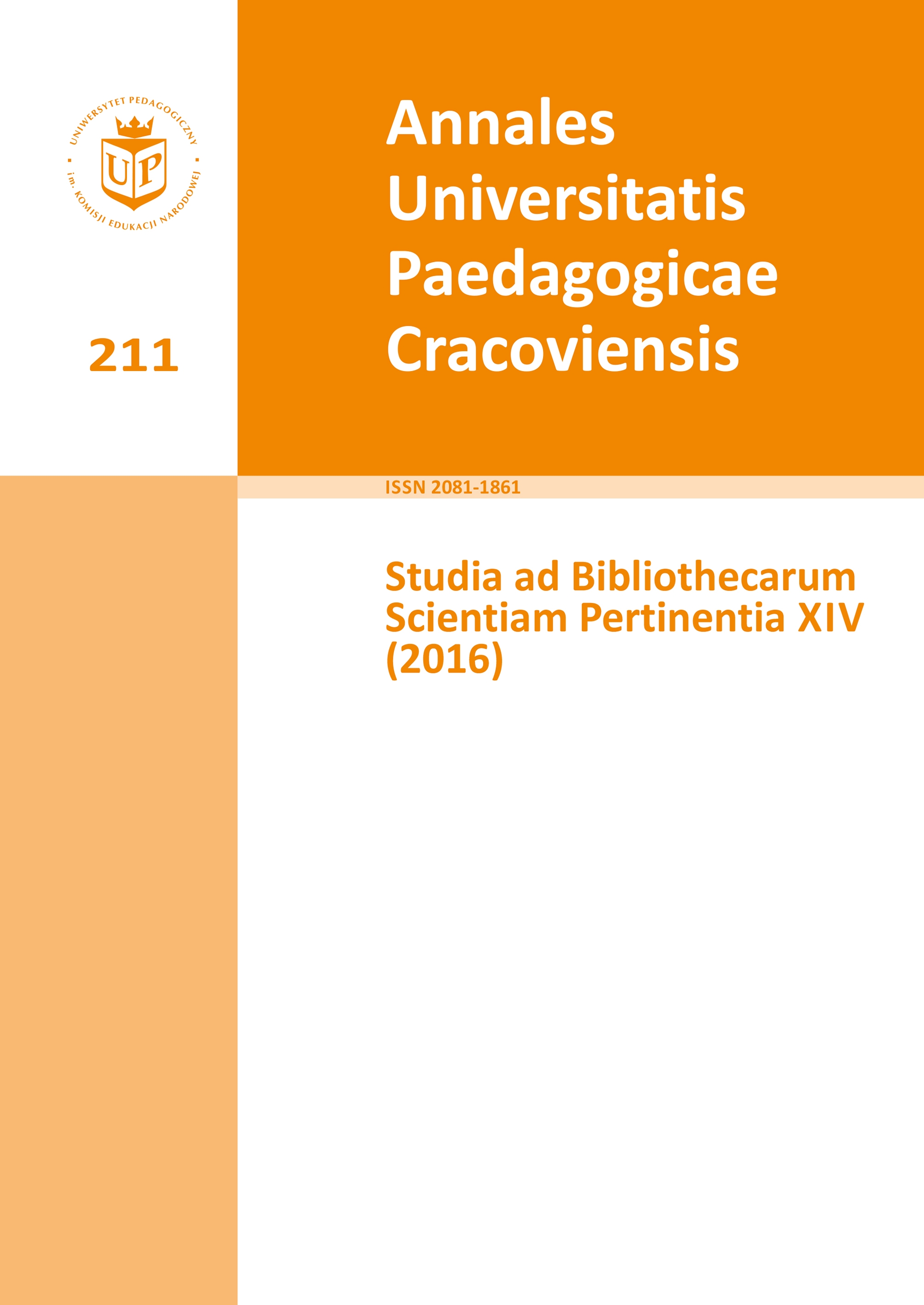Library services in the perspective of search engine optimization
DOI:
https://doi.org/10.24917/20811861.14.2Keywords:
libraries, Poland, search engine optimization, SEOAbstract
This article attempts to answer the question whether the websites of large Polish libraries apply principles of SEO (Search Engine Optimization). The study was conducted in four areas, including as follows: 1. study of key words (key word research, key word usage & key word density); 2. analysis of the on-page factors (content & technology); 3. analysis of off-page factors (backlinks & social media); 4. analysis of metrics reputation (brand & confidence metrics). The first area of research is based on the data generated from Google Adwords for the year 2014 (7.411.387 queries, 801 phrases); for subsequent areas material was provided by technical analysis of 13 most visited websites of libraries located in four major academic cities (Warsaw, Krakow, Poznan, Wroclaw). In the article the author examined in detail key words/ phrases, by which users search for local academic libraries, and also examined how the selected libraries’ websites implement SEO guidelines. The point of reference in the diagnosis of current factors were correlation reports of companies: Searchmetrics (SEO Ranking Factors and Rank Correlations 2014, 2015) and MOZ (Search Engine Ranking Factor 2015). Empirical research was based on data as of February 2015References
Bailyn, E. (2014). PageRank vs. TrustRank in Google’s Algorithm, [Blog] „FirstPageSage” (July 29) - http://firstpagesage.com/seo-blog/seo-basics/pagerank-vs-trustrank-in-googles-algorithm/ [2016.04.04].
Cutts, M. (2007). Trust Rank Explained [Suresh Babu Interviews Matt Cutts in Pubcon 2007], YouTube (11 Dec.) – https://youtu.be/p8mUXQzwEvs [2016.04.03].
Danowski, B.; Makarczuk, M (2007). Pozycjonowanie i optymalizacja stron WWW. Gliwice: Wydawnictwo Helion (wyd. 2 – 2009, wyd. 3 – 2011).
Enge, E.; Spencer, S.; Stricchiola, J. (2016). SEO, czyli sztuka optymalizacji witryn dla wyszukiwarek. Wyd. 3. Gliwoce: Helion.
Gabe, G. (2014). Penguin 3.0 Analysis – Penguin Tremors, Recoveries, Fresh Hits, and Crossing Algorithms, [blog] "G-Squared Interactive Maketing Blog" (October 27) - http://www.gsqi.com/marketing-blog/penguin-3-analysis-findings [2016.05.30].
Gasparotto, M. (2014). Search Engine Optimization for the Research Librarian: A Case Study Using the Bibliography of U.S. Latina Lesbian History and Culture, Practical Academic Librarianship: The International Journal of the SLA Academic Division, vol. 4, no 1, pp. 15-34 - https://journals.tdl.org/pal/index.php/pal/article/view/6971 [2016.05.25].
Gemius (2016). Wyszukiwarki–silniki. Ranking gemius Traffic - http://www.ranking.pl/pl/rankings/search-engines.html [2016.04.04].
Google (2016). Google Algorithm Change History - https://moz.com/google-algorithm-change [2016.04.04].
Iwanek, Ł. (2014). 10 mitów na temat SEO, e-Gospodarka (2014-10-07) - http://www.egospodarka.pl/116534,10-mitow-na-temat-SEO.html [2016.05.10].
Jaskowska, B. (2009). Efektywny marketing SEO witryny bibliotecznej w wyszukiwarkach, Przegląd Biblioteczny, z. 2, s. 229-238.
Kenning, A.; OBrien, P. & Rossmann, B. (2013). Managing search engine optimization: An introduction for library administrators, Journal of Library Administration, vol. 53, no 2-3, pp. 177-188. doi: 10.1080/01930826.2013.853499 [2016.05.25].
Kliszczak, M. (2014). Pozycjonowanie (SEO) w internecie – fakty i mity, Eactive Blog (11/02/2014) - https://www.eactive.pl/pozycjonowanie-stron/pozycjonowanie-w-internecie-fakty-i-mity/ [2016.05.10].
Krishnan, V., & Raj, R. (2006). Web Spam Detection with Anti-Trust Rank. In Proceedings of the Second International Workshop on Adversarial Information Retrieval on the Web – AIRWeb 2006. Vol. 6, pp. 37-40 - http://airweb.cse.lehigh.edu/2006/krishnan.pdf [2016.04.04].
Lee, S.; Jang W.; Lee, E.; Oh, S.G. (2016). Search engine optimization: A case study using the bibliographies of LG Science Land in Korea, Library Hi Tech, 2016, vol. 34, iss. 2, pp.197-206, doi: 10.1108/LHT-02-2016-0014 [2016.05.30].
MOZ (2015). Search Engine Ranking Factors 2015. Expert Survey and Correlation Data, MOZ Blog - https://moz.com/search-ranking-factors [2016.04.04].
Onaifo, D.; Rasmussen, D. (2013). Increasing libraries' content findability on the web with search engine optimization, Library Hi Tech, vol. 31, iss. 1, pp. 87-108, doi: 10.1108/07378831311303958 [2016.05.25].
Patel, J., & Patel, S. (2014). Efficient calculation of PageRank using TrustRank and Anti-TrustRank. International Journal of Engineering Development and Research, vol. 2, iss. 2, pp. 1895-1898 - http://www.ijedr.org/papers/IJEDR1402098.pdf [2016.05.16].
Patil Swati, P.; Pawar, B.V. & Patil Ajay, S. (2013). Search Engine Optimization: A Study, Research Journal of Computer and Information Technology Sciences, vol. 1 (1), pp. 10-13 - http://www.retawprojects.com/uploads/search_engine.pdf [2016.05.16].
Petrescu, P. (2014). Google Organic Click-Through Rates in 2014, MOZ Blog (October 1st) - http://moz.com/blog/google-organic-click-through-rates-in-2014 [2016.05.30].
Piekarski, K. (2014). Ekonomia percepcji. Mechanizmy selekcjonowania informacji w internecie [praca doktorska]. Katowice: Uniwersytet Śląski w Katowicach - http://www.sbc.org.pl/Content/126980/doktorat3505.pdf [2016.04.04].
Sadowski, T. (2013). Penguin 2.1 – zwany również Pingwinem 5 – co to jest, skąd się wzięło i jak sobie z nim radzić, GoogleWatchers SEO BLOG (6 października) - http://googlewatchers.info/google/penguin-2-1-co-to-jest [2016.05.30].
Scott, D. (2015). White Hat Search Engine Optimization (SEO): Structured Web Data for Libraries, Partnership: The Canadian Journal of Library and Information Practice and Research, vol. 10, no 1 - doi: 10.21083/partnership.v10i1.3328 [2016.05.25].
Seymour, T.; Frantsvog, D. & Kumar, S. (2011). History of search engines, International Journal of Management and Information Systems, 15(4), pp. 47-59, http://www.minot.com/tom/JIS.pdf [2016.05.19].
Shepard, C. (2015). 10 SEO Myths that Friggin' Tick Me Off, MOZ Blog (March 9th, 2015) - https://moz.com/blog/seo-myths [2016.05.21].
Sullivan, D. (2016). RIP Google PageRank score: A retrospective on how it ruined the web, Search Engine Land (March 9, 2016) - http://searchengineland.com/rip-google-pagerank-retrospective-244286 [2016.05.30].
Tober, M.; Furch D.; Londenberg, K.; Massaron, L.; Grundmann, J. (2015). Search Ranking Factors and Rank Correlations 2015. San Mateo: Searchmetrics - http://www.searchmetrics.com/knowledge-base/ranking-factors/ [2016.04.04].
Tober, M; Hennig, L.; Furch, D. (2014). SEO Ranking Factors and Rank Correlations 2014. San Mateo: Searchmetrics - http://www.searchmetrics.com/knowledge-base/ranking-factors-2014/ [2016.04.04].
Van Dijck, J. (2013). The culture of connectivity: A critical history of social media. Oxford: University Press.
Wang, F.; Li Y. & Zhang, Y. (2011). An Emphirical study on the Search Engine Optimization Technique and Its Outcomes, in. Artificial Intelligence, Management Science and Electronic Commerce (AIMSEC) Procedings of 2nd International Conference on AIMSEC, pp, 2767- 2770, doi: 10.1109/AIMSEC.2011.6011361 [2016.04.04].
Downloads
Published
How to Cite
Issue
Section
License
Copyright (c) 2017 AUPC Studia ad Bibliothecarum Scientiam Pertinentia

This work is licensed under a Creative Commons Attribution 4.0 International License.

